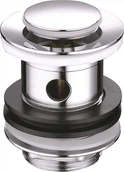Adjusting the water flow in your bathtub drain is an essential skill that can enhance your bathing experience and prevent potential plumbing issues. As a leading bathtub drain supplier, I understand the importance of having a well - functioning drain system. In this blog, I'll share some insights on how to adjust the water flow in your bathtub drain.


Understanding the Basics of Bathtub Drain Systems
Before you start adjusting the water flow, it's crucial to have a basic understanding of how your bathtub drain system works. A typical bathtub drain consists of a strainer, a trap, and a drainpipe. The strainer catches hair, debris, and other solid objects to prevent them from clogging the drain. The trap is a U - shaped pipe that holds a small amount of water to block sewer gases from entering your bathroom. The drainpipe carries the water from the bathtub to the main sewer line.
Common Causes of Poor Water Flow
There are several reasons why you might experience poor water flow in your bathtub drain. One of the most common causes is a clog. Hair, soap scum, and other debris can accumulate in the strainer, trap, or drainpipe over time, restricting the flow of water. Another cause could be a faulty drain stopper. If the stopper doesn't open or close properly, it can affect the water flow. Additionally, issues with the plumbing system, such as a collapsed drainpipe or a blockage in the main sewer line, can also lead to slow - draining water.
Steps to Adjust the Water Flow
1. Clean the Strainer
The first step in adjusting the water flow is to clean the strainer. Remove the strainer from the bathtub drain by unscrewing it or lifting it out, depending on the type of strainer you have. Use a pair of tweezers or a small brush to remove any hair, debris, or soap scum that has accumulated in the strainer. Rinse the strainer under running water to ensure it's completely clean. Once the strainer is clean, reinstall it in the bathtub drain.
2. Check the Drain Stopper
If cleaning the strainer doesn't improve the water flow, the next step is to check the drain stopper. There are different types of drain stoppers, such as pop - up stoppers, lift - and - turn stoppers, and toe - touch stoppers. For a pop - up stopper, try pressing down on the stopper to see if it opens and closes properly. If it's stuck, you can try using a pair of pliers to gently wiggle it free. For a lift - and - turn stopper, make sure you can lift and turn it smoothly. If the stopper is damaged, you may need to replace it. You can find a variety of high - quality drain stoppers in our product range, including Short Basin Waste, which is a great option for many bathtub drain systems.
3. Clear the Trap
If the strainer and the drain stopper are in good condition, but the water is still draining slowly, the problem may be in the trap. The trap is located under the bathtub, usually close to the wall. You can access the trap by removing the access panel or crawling under the bathtub. Place a bucket under the trap to catch any water that may spill out. Use a wrench to loosen the nuts on the trap and remove it. Clean the trap thoroughly by flushing it with hot water and using a brush to remove any debris. Once the trap is clean, reinstall it and tighten the nuts.
4. Use a Drain Cleaner
If the above steps don't solve the problem, you can try using a drain cleaner. There are different types of drain cleaners available, such as chemical drain cleaners and natural drain cleaners. Chemical drain cleaners contain strong chemicals that can dissolve hair, soap scum, and other debris. However, they can also be harmful to your plumbing system and the environment. Natural drain cleaners, on the other hand, are made from natural ingredients and are safer to use. You can make a natural drain cleaner by mixing equal parts of baking soda and vinegar. Pour the mixture down the drain and let it sit for about 30 minutes. Then, flush the drain with hot water.
5. Inspect the Drainpipe
If the water flow is still poor after trying all the above steps, the problem may be in the drainpipe. Inspect the drainpipe for any signs of damage, such as cracks or leaks. If you notice any damage, you may need to replace the drainpipe. In some cases, the drainpipe may be blocked by a more significant object, such as a toy or a piece of jewelry. If you suspect a blockage in the drainpipe, it's best to call a professional plumber.
Upgrading Your Bathtub Drain System
If you're still having issues with the water flow in your bathtub drain, or if you want to improve the overall performance of your drain system, you may consider upgrading it. We offer a wide range of high - quality bathtub drain products, including Basin Waste And Overflow Kit and Flip Plug Basin Waste. These products are designed to provide better water flow, prevent clogs, and enhance the aesthetic appeal of your bathroom.
Contact Us for Your Bathtub Drain Needs
As a trusted bathtub drain supplier, we are committed to providing our customers with the best products and services. Whether you're looking for a simple drain stopper or a complete bathtub drain system upgrade, we have the expertise and the products to meet your needs. If you have any questions or would like to discuss your bathtub drain requirements, please don't hesitate to contact us. We look forward to working with you to ensure a smooth - flowing and trouble - free bathtub drain system.
References
- "Plumbing for Dummies" by Roy Barnhart
- "The Home Depot Guide to Plumbing" by The Home Depot






